Live from Madrid: LaLiga showcases new-season innovation slate at Civitas Metropolitano
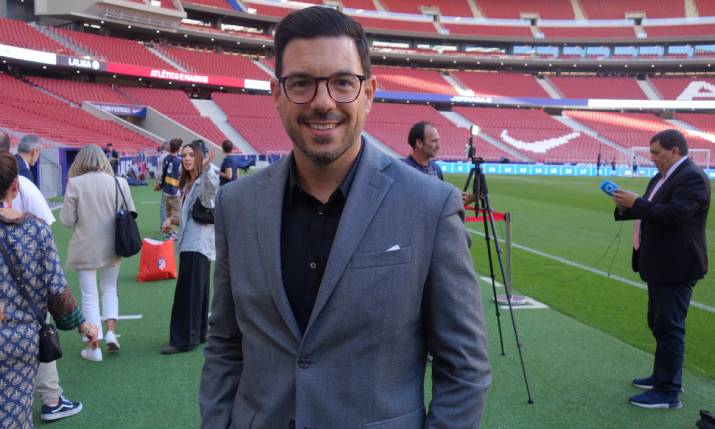
Roger Brosel, head of content and programming for LaLiga, before the Atlético Madrid v Cádiz match
The LaLiga clash between Atlético Madrid and Cádiz on Sunday night (1 October 2023) highlighted a range of broadcast innovations introduced by the league this season across enhanced camera coverage, increased access to players and coaches, a new AR graphics identity, use of cinematic storytelling, and a declared desire to enhance interactivity and gamification around match-day presentation.
The innovation slate was launched to coincide with the opening round of fixtures in August, all coming to fruition through LaLiga’s new sponsorship partnership with EA Sports which has acted as a catalyst for change throughout the Spanish league’s audiovisual approach and output.
The camera plan for this match at the Metropolitano stadium featured 20 cameras, including an RF SteadiCam-rigged Sony Venice cinematic camera, two net cams, two goal line cameras and a drone flying over the stadium (around the compound but not within the stadium itself).
The drone featured a DJI Mavic 3 Cine camera with Hasselblad L2D-20C zoom lens. Drones are now used in six LaLiga games per week, providing better pre-match, half-time and post-match pictures, with AR graphics included for selected matches.
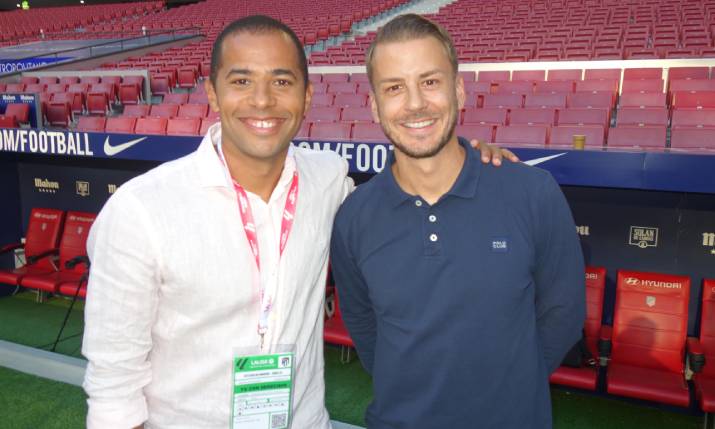
DAZN broadcast commentary team for Sunday night’s match: Alberto Edjogo-Owono (L) and Andrea Orlandi
Some of the match cameras in Madrid were also used for the pre-show programming, including pitch inspection player interview, teams arrivals, dressing rooms and a flash/superflash and pitch flash player/coach interview camera for domestic match broadcaster DAZN.
The SkyCam can move up to 21 metres from the pitch, suspended by four cables in a diagonal pattern. The aerial camera provides a unique perspective as it can move up, down, left and right. Thanks to an agreement with all the clubs, LaLiga has placed fixed SkyCams in 16 of 20 LaLiga EA Sports stadiums. If a team is relegated at the end of the season, the aerial camera rig is removed from the stadium and installed in the stadium of a promoted team.
LaLiga bolsters its camera plan for the two El Classico matches between Barcelona and Real Madrid each season with a 31-camera plan, simulcast 4K HDR-HD production, six super slow motion cameras, four high speed cameras (two Polecam and two on key players), two cameras dedicated exclusively to the coach of each team, two beauty shots (one inside and one outside the stadium), a heli and a drone, and 12 EVS replay systems. LaLiga believes a production of this level can only be compared to very top matches such as the World Cup Final or UEFA Champions League Final.
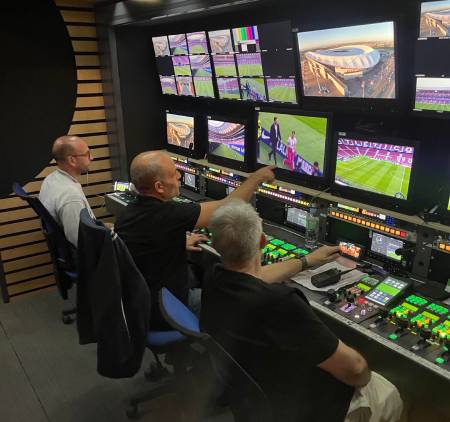
MediaPro camera shading team prepares for match coverage at Stadio Civitas Metropolitano
Bringing football closer to fans
Andrea Orlandi and Alberto Edjogo-Owono were co-commentators for DAZN on Sunday night. Orlandi said, “It’s great that we are bringing football closer to fans. Tonight I’ll be able to interview a player before the match, just to ask him about his feelings, have a look at the grass and ask him what kind of studs he’s going to use for the game and so on. And then we’ll do the post-game analysis on the pitch with the protagonists, and I’m hoping to go into the Cadiz dressing room if they win!
“I think the players and coaches understand that they are part of this circus, and they need to engage more with the fans”
“But the use of technology helps us massively, and visually as well,” said Orlandi. “We’re able to explain better what is happening on the pitch, what areas the teams are attacking, here’s where they press. This season visually it looks even better, which is fantastic, and it makes our jobs easier. We love being close to everything that happens on the pitch, and the information that we can give to the fans is top notch.”
“I think the most important thing here is the experience for the fans who are watching on TV,” said Alberto Edjogo-Owono. “Nowadays we can watch on Netflix, we can watch on Prime, we can see a lot of things. Nowadays people do not consume football all the time focused on the match. Maybe I have another screen open here, WhatsApp or whatever, I don’t know. So I think the experience is very important and the technology helps us a lot.
“Then we have the players and the coaches: I think they don’t like it so much. They want to keep the intimacy of the dressing room. But I think they understand now that it is important, this engagement with the fans. Young people, especially, they are watching other things: the players and coaches understand that.
“But it is step by step. I think the first weeks of the season, they don’t like it — especially the ‘old school’ coaches. But I think they understand that they are part of this circus, and they need to engage more with the fans,” said Edjogo-Owono.
Roger Brosel, head of content and programming for LaLiga, is leading the series of changes implemented this season around match coverage. “We are focused a lot on new regulations that allow us better access to content like dressing rooms before and after the games and listening to managers during water breaks etc. You can have as many cameras as you like but if you’ve got nothing interesting to show, it’s more difficult.
“Better access is top of the list. We had regulations that were in place since season 2016/17, when we were not selling the rights collectively. Clubs were sending the rights individually. So we had nothing to do in terms of how we exploited the rights or how we produced the matches.
“From 16/17 we started producing our own feed, so it’s a different model now where we produce all our own games. We hire a company called Mediapro to do so, but it is done with our own standards and then we distribute the feed to whoever is the rightsholder at the time. Right now it’s Movistar and DAZN.
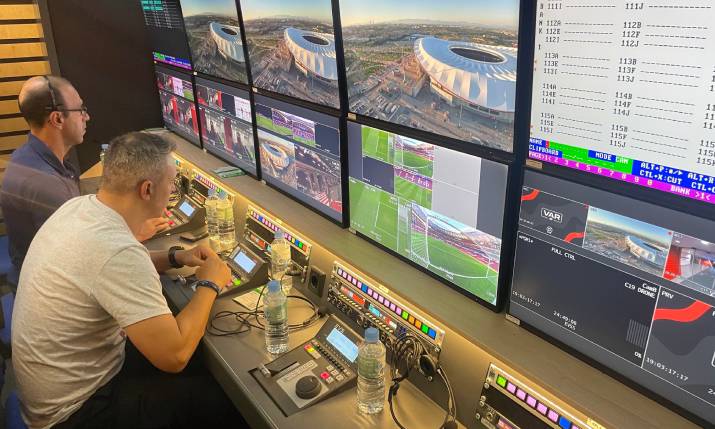
EVS operators built team arrivals clips ahead of the match, inside MediaPro’s flagship OB91 production truck
“The clubs were really used to the past regulations, but we wanted something more. And we wanted to be more interactive with our audience. We wanted be closer to the fans, and we would use the technology to improve the broadcast. We feel we can take advantage of social media and digital technology and align the digital world with the broadcast world.
“The clubs were really used to the past regulations, but we wanted something more. And we wanted to be more interactive with our audience”
“We have introduced interactive voting for the MVP, using QR codes to keep the fans engaged. We also have multiple camera angles, which is an alternative way for the viewer to enjoy the game. And we have introduced chat, sort of like making a Twitch version of the broadcast of the top games. It has gained a lot of traction and the ratings are going up for this match feed, which is an alternative channel where you can participate,” said Brosel.
“We also wanted the clubs to collaborate in bringing people to the broadcast, in social media. In these new regulations, we have collaborations between players, clubs and our talent in our own channels to remotely do collaborative stuff on match days with players.”
Live games are the main product that LaLiga commercialises to national and international broadcasters. LaLiga is in charge of broadcasting all games in LaLiga EA Sports (380) and LaLiga Hypermotion (462+6). In the current season, LaLiga offers two games per round in 4K-HDR, with a simulcast production approach. The simulcast allows LaLiga to generate a single feed in 4K that is down rezzed afterwards to HD.
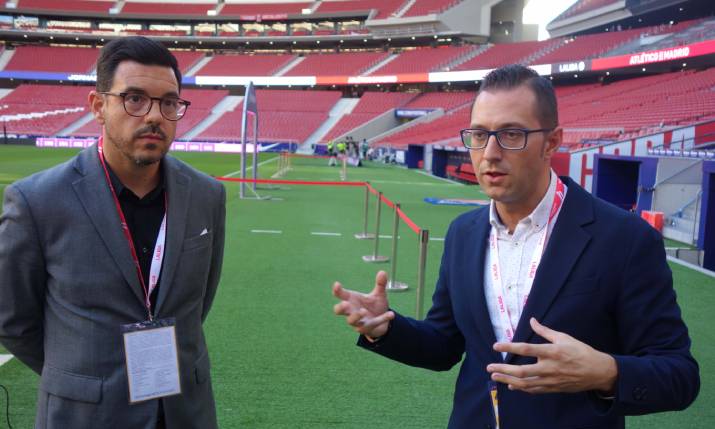
Roger Brosel with Antonio del Castillo Jiménez, head of match directors, LaLiga
Games, graphics and visual identity
One of the most significant developments seen this season is a complete overhaul of the LaLiga graphics package, a change that affects on-air display, the lower third and the scoreboard. The overall aim of the changes implemented in the broadcast is to be able to show new perspectives and angles that, enriched with information, result in a much more immersive viewing experience.
In general terms, the broadcast has moved from the dark tones of black and graphite of recent seasons to bright colours, especially the new corporate colour, a light coral red correctly known as Pantone Red 032C.
The new optics and graphics aim to give a rejuvenated and more dynamic feel, much closer to EA SPORTS FC, with nods to the video game as much as the technology allows. An example of this can be seen in the augmented reality statistical graphics, which are intended to replicate those of the video game, both visually and in terms of the camera angle.
The result is a coexistence of traditional 2D and 3D graphics. Changes this season include application of the stop motion technique, seen in the visualisation of statistics. Thanks to this, the viewers sees the players in various positions doing various actions, including celebratory poses.
The size of the graphics has increased, with the aim of achieving certain visibility on other types of devices beyond TVs. And each team has its own colour code, primary and secondary, customising all the graphics of the various events that take place on the pitch.
All the audiovisual changes in the First Division are also reflected in La Liga’s Second Division. However it has been given its own visual identity, characterised by a turquoise blue colour, Pantone 2226U.
A particular innovation is a new LaLiga font, simply called LaLiga, so that typography is unified across all of the brand’s touch points – TV, online and offline. There is also the addition of what Broset calls a “secret code”, where secondary elements of the new LaLiga logo are introduced separately on-screen and come together to add another layer of motion identity iconography.
“With AR tools we mastered almost accidentally during the Covid period, we wanted to start producing content on the pitch that is easy to read and allows us to introduce more data and sophistication without interrupting the game and without filling the screen with a lot of graphics that sometimes need a lot of explanation,” said Brosel.
“We’re trying to find ways to explain trends in play and multiple player stats to people in a very visual and easy to understand way using augmented reality graphics. And we also wanted these new graphics to have a really easy-to-see connection to the videogame. These graphics now feature in the live broadcast, during the game.
“We always said, years ago, that the coolest videogame was the one that got closest to the broadcast. It looked like you were playing in the broadcast, with commentary, replays and the same angles,” said Brosel.
“Technology for video game developers has evolved so much and they have no physical limitations whatsoever, as they only function in the digital world, placing a camera wherever they want. We cannot do so of course, but we try to replicate some of the angles for example by placing the aerial camera very low and introducing some of these AR graphics.
“My dream is to have the aerial camera tracked – but this is difficult as it moves in three directions and it loses the marks. So far there is no system that does everything we require: but we’ll get there!”

